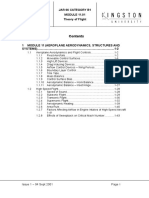Air India Brief Introduction
Air India Brief Introduction
Uploaded by
Pragna KundaCopyright:
Available Formats
Air India Brief Introduction
Air India Brief Introduction
Uploaded by
Pragna KundaOriginal Description:
Original Title
Copyright
Available Formats
Share this document
Did you find this document useful?
Is this content inappropriate?
Copyright:
Available Formats
Air India Brief Introduction
Air India Brief Introduction
Uploaded by
Pragna KundaCopyright:
Available Formats
AIR INDIA
Brief Introduction
Indias aviation sector is enjoying a steady growth. Passenger output rose to 144 million in
FY 2011 from 73 million in FY 2006, as per a joint study by FICCIKPMG (2012). This
positive growth path can be attributed to the 11th Five-Year Plan (20072012). This period
witnessed the completion of four international airport projects through the publicprivate
partnership (PPP) mode; it was also during this period that five Indian carriers began to
function on international routes.
Air transport in India today supports 56.6 million jobs and produces over US$ 2.2 trillion of
the global gross domestic product (GDP). Air passenger traffic is also increasing at a healthy
rate, a development driven by modern facilities and infrastructure.
The Centre had set aside an investment of US$ 12.1 billion in the airports sector during the
12th Five-Year Plan period, of which US$ 9.3 billion is projected to come from Indias
private sector for construction of new and low-cost airports and development of existing
ones.
Market Size
India would be the third largest aviation market by 2020, as per Mr Ajit Singh, Minister for
Civil Aviation, Government of India.
Passenger throughput increased to 159 million and cargo to 2.19 million metric tonnes
(MMT) in FY 2013, a compound annual growth rate (CAGR) of 13 per cent and 10 per cent
respectively over the period FY 20032013, as per data from the Airports Authority of India
(AAI).
The Indian civil aviation industry is among the top 10 globally with a size of around US$ 16
billion, as per a KPMG report.
Investments
The foreign direct investment (FDI) inflows in air transport (including air freight) during
April 2000 to March 2014 stood at US$ 495.24 million, as per data released by Department
of Industrial Policy and Promotion (DIPP).
The following are some of the major investments and developments in the Indian aviation
sector:
Tata-Singapore Airlines plans to launch its services in India from September 2014,
with 87 weekly flights in its first year of operations, as stated in the airlines
application for an air operators permit to the Directorate General of Civil Aviation
(DGCA). These flights will link Delhi with Ahmedabad, Bangalore, Chandigarh, Goa,
Hyderabad, Jammu, Mumbai, Patna, and Srinagar.
Bengaluru-based GMR Infrastructure has won a contract to upgrade Mactan-Cebu
international airport in the Philippines. GMR Infra and its partner, Philippine firm
Megawide Construction will make an upfront concession payment of US$ 325 million
and invest US$ 375 million over the next five years to build a new terminal and
upgrade the current one.
The DGCA granted an air operators permit (AOP) to AirAsia on May 7, 2014,
opening the path for the airline company to launch low-cost services in India. AirAsia
India will launch services with three Airbus A320 aircraft, from its Chennai hub.
Trichy in Tamil Nadu has, over the past few years, become the fastest growing
international airport in India. International passenger traffic in the town increased 382
per cent to 773,423 between 200607 and 201213. This year, it is expected to
become the 10th biggest international airport in the country.
Low-cost airline SpiceJet is changing its network strategy in order to be more cost
effective and have better yields. The airline signed a US$ 4.4-billion deal in March
2014, for 42 fuel-efficient Boeing 737 Max planes which would be delivered from
2018 onwards.
Government Initiatives
Indias Ministry of Civil Aviation revised the bilateral air traffic entitlements with Dubai in
February 2014, permitting them a 20 per cent increase in seats to India. We have allocated
Dubai 11,000 seats in three phases till the summer schedule of 2015. Dubai has agreed to
grant change-of-gauge facility for Indian carriers at the existing airport, as per a senior
official of the Ministry.
The Ministry has also signed a Memorandum of Understanding (MoU) with AAI for FY
201415, which lists targets to be achieved by AAI on some key performance areas during
the fiscal. The main features of the MoU include parameters such as risk management,
implementation of Enterprise Resource Planning (ERP) tools and development of disaster
management plan.
Delhi Airport will soon become a zero-diversionary airport. The Committee set up by the
DGCA to look into the matter, has presented its report with 27 recommendations. There were
57, 89 and 143 diversions in 2011, 2012 and 2013, respectively. Chances of diversions of
flights at Delhi Airport are expected to come down drastically after the recommendations
have been implemented.
Road Ahead
The aviation industrys potential in India is massive. The market already caters to about 150
million passengers passing through its many airports, with the potential to grow further. By
2020, traffic at airports in India is anticipated to reach 450 million. The aviation industry
presently supports about 0.5 per cent of the Indias GDP.
A KPMG report notes that the industry will continue to grow in India on the back of the
performance of regional airports. Currently, there are about 450 used/un-used/abandoned
airports and airstrips spread across India. Many Indian states, particularly in Eastern India,
have begun taking steps to promote air connectivity. Still, more needs to be done. Today,
many Tier II and Tier III cities are unconnected. The proposed Essential Air Services Fund
(EASF) by the Ministry of Civil Aviation needs to be established as quickly as possible. All
this will have a multiplier effect with regards to higher growth of tourism, employment and
local economic activities in the country.
Exchange Rate Used: INR 1 = US$ US$ 0.0166 as on June 26, 2014
References: Media Reports, Press Releases, Press Information Bureau, Directorate General
of Civil Aviation (DGCA), KPMG Report, FICCIKPMG Report
You might also like
- Aviation Industry in IndiaDocument21 pagesAviation Industry in Indiasandsoni2002No ratings yet
- Eco Project 1 Class12Document4 pagesEco Project 1 Class12Tirth Dugar67% (3)
- Air Asia-Low Cost Airline Entry To India: Page 1 of 18Document18 pagesAir Asia-Low Cost Airline Entry To India: Page 1 of 18PrathapNo ratings yet
- Sukhoi 30-MKIDocument7 pagesSukhoi 30-MKItjprajin100% (1)
- AviationDocument3 pagesAviationSuhas TambeNo ratings yet
- Indian AviationDocument5 pagesIndian AviationLALITH NARAYANA RAO VELAGANo ratings yet
- Launching All New Grounds With ElanDocument1 pageLaunching All New Grounds With ElanPushkar HatéNo ratings yet
- Jet - EtihadDocument21 pagesJet - EtihadPooja KhandwalaNo ratings yet
- GRCCCM NOTESAviation Industry Current NewsDocument9 pagesGRCCCM NOTESAviation Industry Current NewschandanNo ratings yet
- Indian Aviation SectorDocument14 pagesIndian Aviation SectorSunny RaoNo ratings yet
- Market SizeDocument3 pagesMarket Sizerishabh lohiyaNo ratings yet
- Aviation Last Updated: December 2010Document10 pagesAviation Last Updated: December 2010Ashish KhandelwalNo ratings yet
- Future of Work in Aviation Industry Concept PaperDocument8 pagesFuture of Work in Aviation Industry Concept PaperPalak Makhija100% (1)
- Indian Aviation IndustryDocument12 pagesIndian Aviation Industrysreelakshmi sureshNo ratings yet
- Delhi International Airport LTD.: A Write-Up On Project Financing & PPPDocument41 pagesDelhi International Airport LTD.: A Write-Up On Project Financing & PPPPulokesh GhoshNo ratings yet
- Strategic Management: Industry-Aviation Company - IndigoDocument27 pagesStrategic Management: Industry-Aviation Company - IndigoSatwik GinodiaNo ratings yet
- Manisha - Shadangi - BEL - SEM 1 CPDocument5 pagesManisha - Shadangi - BEL - SEM 1 CPmanishashadangi01No ratings yet
- National Civil Aviation PolicyDocument6 pagesNational Civil Aviation PolicyMd Sarfaraz NawazNo ratings yet
- CivilAviation FactsDocument7 pagesCivilAviation FactsGOPINATHNo ratings yet
- UNIT1Document16 pagesUNIT1soumyakumari kpNo ratings yet
- Airport Construction Management: Prof. Abhishek ShrivasDocument31 pagesAirport Construction Management: Prof. Abhishek Shrivasben hurNo ratings yet
- "Competition in The Aviation Sector": Submitted ToDocument25 pages"Competition in The Aviation Sector": Submitted TopermanikaNo ratings yet
- Indian Airlines: 7P'S, Strategies & RecommendationsDocument44 pagesIndian Airlines: 7P'S, Strategies & RecommendationsBhanu MehraNo ratings yet
- Aviation - Market PlayersDocument8 pagesAviation - Market PlayersShiva Prajapati0% (1)
- Special Report - Putting The Pieces TogetherDocument5 pagesSpecial Report - Putting The Pieces TogetherRonit GuptaNo ratings yet
- Aviation Sector of India: 9th Largest 24% 400 Per Cent Third Largest 46.8 MillionDocument3 pagesAviation Sector of India: 9th Largest 24% 400 Per Cent Third Largest 46.8 MillionSaransh MahajanNo ratings yet
- Indira Gandhi International Airport Development Project: Submitted ToDocument22 pagesIndira Gandhi International Airport Development Project: Submitted ToCharu DuggalNo ratings yet
- Introduction To Aviation IndustryDocument16 pagesIntroduction To Aviation Industrysoumyakumari kp0% (1)
- Spice JetDocument10 pagesSpice JetSurabhi BajiraoNo ratings yet
- The Goals For Aviation Sector State Is Aiming at Are As UnderDocument10 pagesThe Goals For Aviation Sector State Is Aiming at Are As UnderPanchal Abhishek JagdishchandraNo ratings yet
- AviationDocument37 pagesAviationDeepika RaoNo ratings yet
- Travelport WorkshopDocument13 pagesTravelport WorkshopgirishimmortalNo ratings yet
- Aviation ReportDocument18 pagesAviation Reportbinzidd007No ratings yet
- A Spicy AffairDocument16 pagesA Spicy AffairPravin SinghNo ratings yet
- Aviation Industry RRDocument13 pagesAviation Industry RRrishabh lohiyaNo ratings yet
- AviationDocument17 pagesAviationTanisha100% (1)
- Industry Analysis Project (Indigo)Document30 pagesIndustry Analysis Project (Indigo)amar82% (11)
- Consumer Behavior Analysis of The Airline Sector: A Case of Air IndiaDocument16 pagesConsumer Behavior Analysis of The Airline Sector: A Case of Air IndiaRohtash Singh RathoreNo ratings yet
- Jet Airways-Research MethodologyDocument36 pagesJet Airways-Research MethodologyNiket DattaniNo ratings yet
- A Case Study On Strategic Positioning of Vistara: Analysis and Forecasting Way AheadDocument11 pagesA Case Study On Strategic Positioning of Vistara: Analysis and Forecasting Way AheadShailendra PrajapatiNo ratings yet
- PM Project IGIDocument22 pagesPM Project IGIBulle ShahNo ratings yet
- IndigoDocument11 pagesIndigoanil yadavNo ratings yet
- AviationDocument26 pagesAviation9051158426arNo ratings yet
- Capital Budgeting and Risk Analysis at SpiceJetDocument33 pagesCapital Budgeting and Risk Analysis at SpiceJetriddhi tulshianNo ratings yet
- Fdi in Aviation (Im)Document27 pagesFdi in Aviation (Im)Mohit VermaNo ratings yet
- Synopsis PyDocument2 pagesSynopsis PyimfrankNo ratings yet
- Civil AviationDocument3 pagesCivil AviationRaghav KabraNo ratings yet
- GMR Hyderabad International Airport LimitedDocument60 pagesGMR Hyderabad International Airport LimitedSujith Kumar100% (2)
- Business Communication: Sector: AviationDocument6 pagesBusiness Communication: Sector: AviationGunadeep ReddyNo ratings yet
- Indian Aviation IndustryDocument7 pagesIndian Aviation IndustryAMAN KUMARNo ratings yet
- Airlines Sector in India and Its Contribution in Indian GDPDocument11 pagesAirlines Sector in India and Its Contribution in Indian GDPAnshuman UpadhyayNo ratings yet
- ReferenceDocument29 pagesReferenceAbhi ShiqthNo ratings yet
- SU Mitted in Partial Fulfilment of The Requirements Master of Business Administration (Mba)Document43 pagesSU Mitted in Partial Fulfilment of The Requirements Master of Business Administration (Mba)Ronik PasswalaNo ratings yet
- Aviation Industry in IndiaDocument12 pagesAviation Industry in Indiasalim1321No ratings yet
- Open Sky Di IndiaDocument8 pagesOpen Sky Di IndiaDila NoorNo ratings yet
- C I B A P: Ndian ViationDocument3 pagesC I B A P: Ndian ViationEshan ShailendraNo ratings yet
- Mitre India Final AllDocument58 pagesMitre India Final AllNilesh ShahjiNo ratings yet
- Research Paper On Aviation Industry in IndiaDocument6 pagesResearch Paper On Aviation Industry in Indiaknoiiavkg100% (1)
- Review and Assessment of the Indonesia–Malaysia–Thailand Growth Triangle Economic Corridors: Indonesia Country ReportFrom EverandReview and Assessment of the Indonesia–Malaysia–Thailand Growth Triangle Economic Corridors: Indonesia Country ReportNo ratings yet
- Light Aircraft Pilot LicenceDocument41 pagesLight Aircraft Pilot LicenceTarik MerryleesNo ratings yet
- Ada 508909Document245 pagesAda 508909dasNo ratings yet
- Aircraft Manufacturing Business PlanDocument8 pagesAircraft Manufacturing Business Planaftxgbeofsvteb100% (1)
- Amta 329-Cabin Atmosphere Control System Dornier 328-JetDocument2 pagesAmta 329-Cabin Atmosphere Control System Dornier 328-JetBENoNo ratings yet
- SRM 53-11-11-283-004Document17 pagesSRM 53-11-11-283-004cak sobik100% (4)
- A320 FMGC FlowchartDocument22 pagesA320 FMGC FlowchartNANO SANATNo ratings yet
- Glider AeryDocument4 pagesGlider AeryChris GilesNo ratings yet
- ReportDocument28 pagesReportmuhammad al afiqNo ratings yet
- Sohil Shah 201040071Document1 pageSohil Shah 201040071Navya Nova ChandaliaNo ratings yet
- Easy Ii: Maintenance Help Document: Fsa-00-30-004-R04-ADocument20 pagesEasy Ii: Maintenance Help Document: Fsa-00-30-004-R04-AJefferson CaizaNo ratings yet
- Early Aviation History (1910)Document1 pageEarly Aviation History (1910)CAP History Library100% (2)
- Participants - List - (19 Oct 2023)Document33 pagesParticipants - List - (19 Oct 2023)Manan TyagiNo ratings yet
- Supporting Crew MemberDocument2 pagesSupporting Crew MemberMatěj SedláčekNo ratings yet
- GTG - EDTO - Period of ValidityDocument6 pagesGTG - EDTO - Period of Validityhaider551No ratings yet
- AC 61-23C Chapter 6 CanadaDocument14 pagesAC 61-23C Chapter 6 Canadafarrukhhussain2006No ratings yet
- Airbus New Golden-RulesDocument9 pagesAirbus New Golden-RulesShimeonNo ratings yet
- Design and Performance of A Hang Glider: The School of Mechanical EngineeringDocument36 pagesDesign and Performance of A Hang Glider: The School of Mechanical Engineeringtdit84No ratings yet
- 4 - CH 12-Structural Components of Aircraft - StudentsDocument34 pages4 - CH 12-Structural Components of Aircraft - StudentsUsman Arshad ShahNo ratings yet
- Laboratory Experiment 7: Mohd Ashraf Mohd IsmailDocument14 pagesLaboratory Experiment 7: Mohd Ashraf Mohd IsmailMohd Ashraf Mohd Ismail100% (2)
- FMCS Guide - Complete (GEK 116823 - R1 - ) For Printing) PDFDocument594 pagesFMCS Guide - Complete (GEK 116823 - R1 - ) For Printing) PDFruwanz100% (1)
- Sky Team Alliance Marketing Plan FinalDocument14 pagesSky Team Alliance Marketing Plan FinalgregsteinbrennerNo ratings yet
- Detailed Design of 120 Seater Passenger Aircraft - Aircraft Design Project-IIDocument71 pagesDetailed Design of 120 Seater Passenger Aircraft - Aircraft Design Project-IIShàñkâr À SháñzNo ratings yet
- Bazargan 2016Document17 pagesBazargan 2016FABIAN ESTAY TORRESNo ratings yet
- F-104 Lockheed StarfighterDocument35 pagesF-104 Lockheed Starfightertommy shartNo ratings yet
- CAA (Unmanned Aircraft Systems), Regulations, 2022Document68 pagesCAA (Unmanned Aircraft Systems), Regulations, 2022GeoffLNo ratings yet
- MR Abhishek Yadav x1-1Document2 pagesMR Abhishek Yadav x1-1abhishek yadavNo ratings yet
- Aerodynamics KLMDocument43 pagesAerodynamics KLMarunNo ratings yet
- Fdocuments - in KJFK ChartsDocument32 pagesFdocuments - in KJFK ChartsFercho Anaya MNo ratings yet
























































































